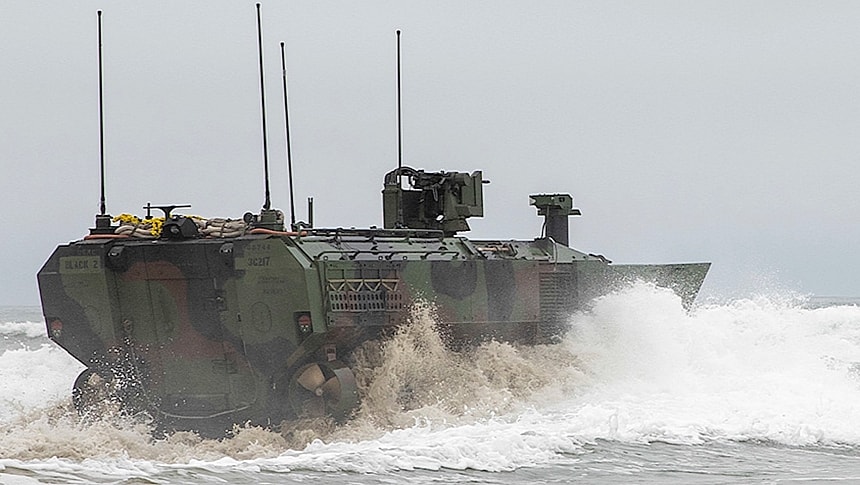Amphibious vehicles are, thanks to their ability to work both on land and on water, a special breed of machines, but they tend to become even more so at the hands of the military. And the U.S. Marine Corps seems determined to show us all how good it is at operating large fleets of them.
The military branch, through its nature, could make good use of amphibious vehicles, and for a long time it tried to get its hands on a proper tool for its needs. Back in the early 2010s, for instance, the Corps was in cahoots with General Dynamics for something called the Expeditionary Fighting Vehicle (EFV).
That program eventually failed, and the U.S. refocused its efforts on something simply called the Amphibious Combat Vehicle (ACV). Manufactured by British defense contractor BAE Systems, the vehicle will become an important element of the Corps' warfighting strategy in the near future.
The ACV is actually not a single vehicle, but a family of them. Still under development, the range will eventually comprise four versions, of which just two are already in service. That would be the Personnel (ACV-P, meant to carry troops) and ACV-C (Command and Control). The remaining pair, the Cannon (ACV-30) and Recovery (ACV-R), are in the Production Representative Test Vehicles (PRTV) stage.
The Marine Corps seems determined to get its hands on as many of these things as possible, and it already burned through four full-rate production orders. The most recent one was announced this week, and it covers $25 million worth of ACVs in the Personnel configuration, but also fielding, sustainment costs, support, and test equipment for the vehicles.
That may seem quite cheap, but when you put things into perspective that feeling changes. The latest $25 million order is just a modification to a $181 million contract awarded earlier. It also brings the total cumulative face value of the ACV contract to a staggering $2.7 billion.
Generally speaking, the 35-ton, 8x8 BAE Systems military vehicles that can drive both on land and in water for a total distance of 325 miles (523 km). When operating on terra firma the speed they can reach is 65 mph (105 kph), but in the water that drops to seven mph (11 kph).
It was the ACV-P version that is the object of this latest order that was delivered first to the Marine Corps. It is the one that can carry 13 combat-ready Marines and three crew.
The ACV-C, the second to be in use, brings command and control capabilities of the amphibious kind, as well as the ability for the vehicle to become part of a Manned-Unmanned Teaming (MUM-T) system.
The Cannon version of the family is the one that can do direct combat thanks to the 30 mm remote turret system it is equipped with, while the ACV-R is properly equipped to handle direct field support, maintenance, and recovery of other Marine Corps assets.
BAE Systems says it will start delivering the bulk of the Marine Corps ACVs in late 2025.
That program eventually failed, and the U.S. refocused its efforts on something simply called the Amphibious Combat Vehicle (ACV). Manufactured by British defense contractor BAE Systems, the vehicle will become an important element of the Corps' warfighting strategy in the near future.
The ACV is actually not a single vehicle, but a family of them. Still under development, the range will eventually comprise four versions, of which just two are already in service. That would be the Personnel (ACV-P, meant to carry troops) and ACV-C (Command and Control). The remaining pair, the Cannon (ACV-30) and Recovery (ACV-R), are in the Production Representative Test Vehicles (PRTV) stage.
The Marine Corps seems determined to get its hands on as many of these things as possible, and it already burned through four full-rate production orders. The most recent one was announced this week, and it covers $25 million worth of ACVs in the Personnel configuration, but also fielding, sustainment costs, support, and test equipment for the vehicles.
That may seem quite cheap, but when you put things into perspective that feeling changes. The latest $25 million order is just a modification to a $181 million contract awarded earlier. It also brings the total cumulative face value of the ACV contract to a staggering $2.7 billion.
Generally speaking, the 35-ton, 8x8 BAE Systems military vehicles that can drive both on land and in water for a total distance of 325 miles (523 km). When operating on terra firma the speed they can reach is 65 mph (105 kph), but in the water that drops to seven mph (11 kph).
It was the ACV-P version that is the object of this latest order that was delivered first to the Marine Corps. It is the one that can carry 13 combat-ready Marines and three crew.
The ACV-C, the second to be in use, brings command and control capabilities of the amphibious kind, as well as the ability for the vehicle to become part of a Manned-Unmanned Teaming (MUM-T) system.
The Cannon version of the family is the one that can do direct combat thanks to the 30 mm remote turret system it is equipped with, while the ACV-R is properly equipped to handle direct field support, maintenance, and recovery of other Marine Corps assets.
BAE Systems says it will start delivering the bulk of the Marine Corps ACVs in late 2025.









